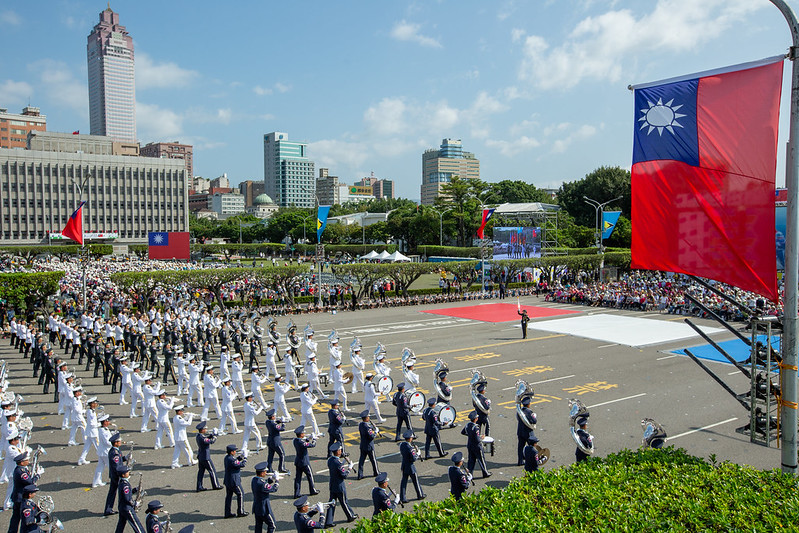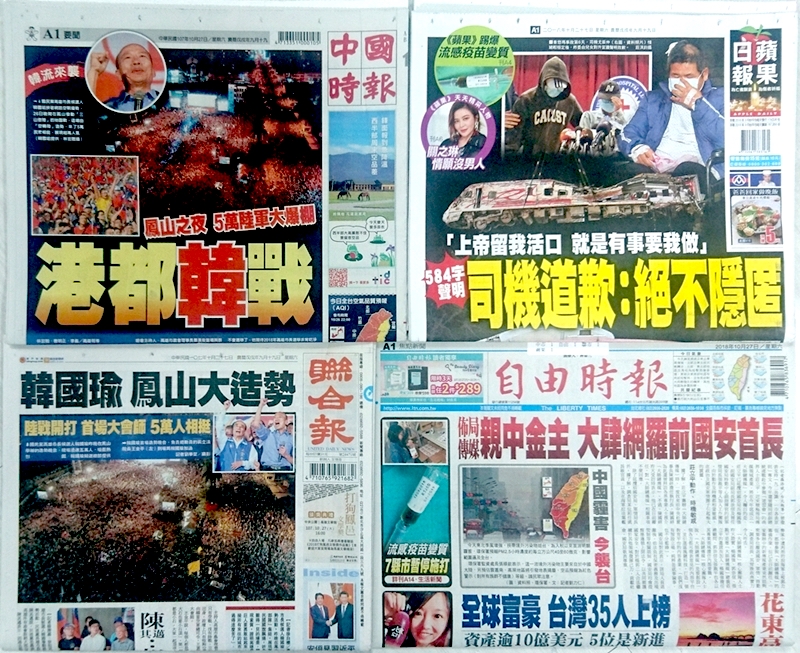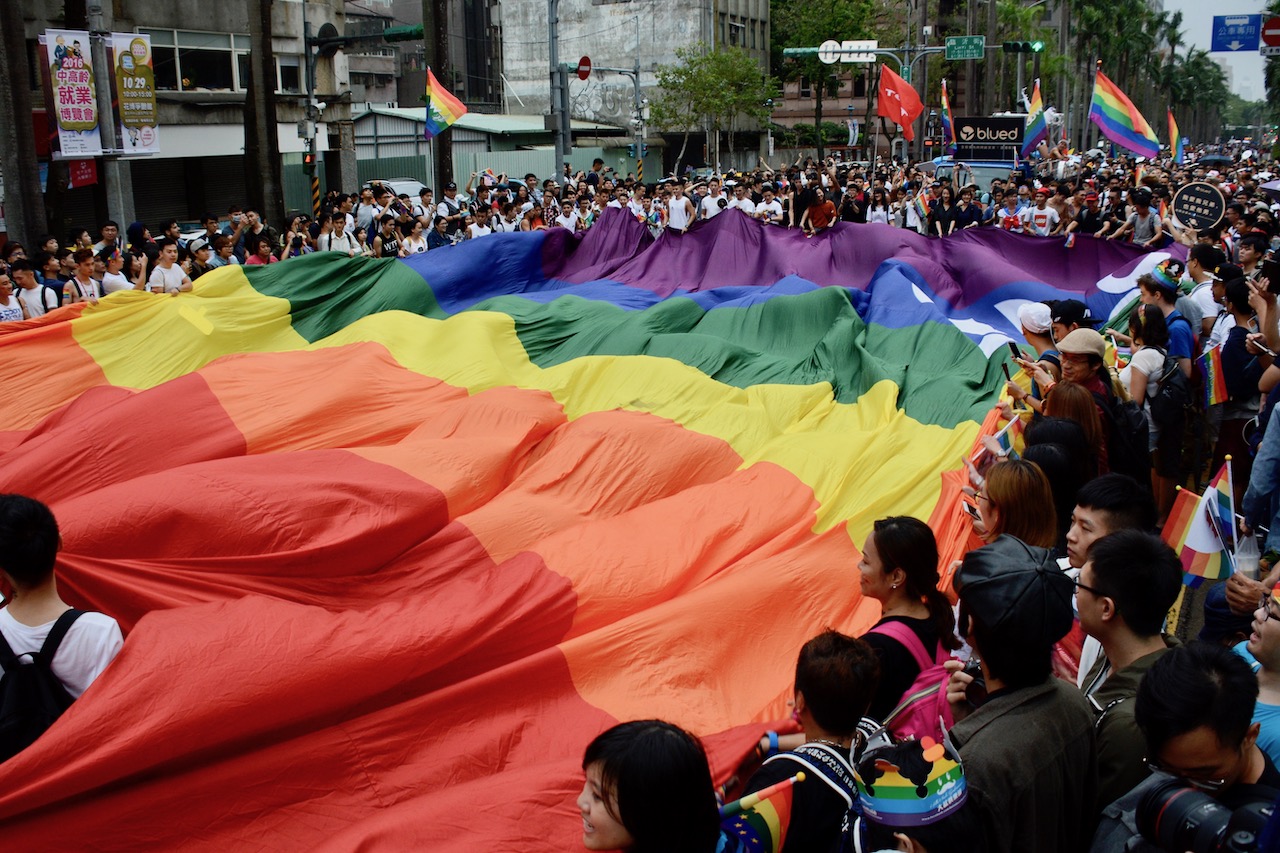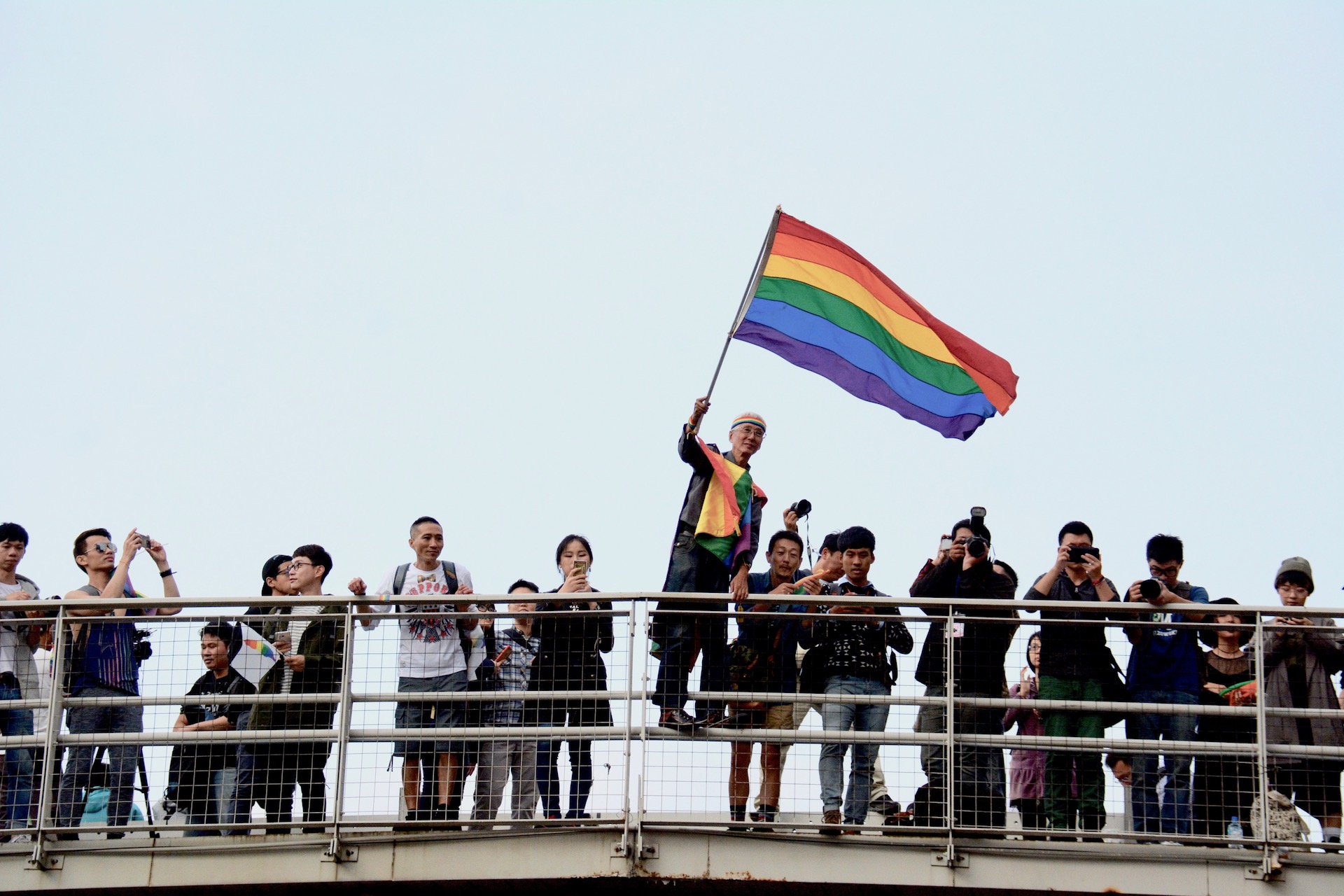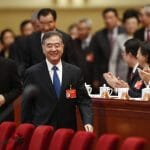Although the KMT has rewritten its rhetoric to appear “rehabilitated” as a functioning party within a democratic system, thinly veiled colonialist and Sino-supremacist sentiments are still fully entrenched within the party’s self-image.
The KMT has long exhibited revisionist tendencies, both at home and abroad. An early example can be found in the chapters of the book Consolidating the Third Wave Democracies: Regional Challenges (1997) provided by James Soong and Lien Chan. Among other things, they state that “the ROC’s democratic reforms were able to be carried out so peacefully and smoothly without incurring excessive social costs” (199) and attribute the lack of democratization to “a war with Japan, a communist rebellion, and nearly half a century of confrontation over the straits” (203). The self-characterization of the Kuomintang (KMT) as enthusiastic harbingers of democratization has continued into the present day, with the party continually pushing for their narrative to supplant history textbooks and curricula that characterize the brutality of martial law.
In Taiwan, the country’s reckoning with the White Terror era and the 228 Massacre is still ongoing and constantly being reevaluated. As the result of many external challenges to the narrative of martial law era being “necessary” and “democracy-oriented,” much of the KMT’s old rhetoric (as shown above) has been discredited in Taiwan. In the past, KMT members, including Ma Ying-jeou, have come out and apologized for the atrocities of the White Terror, and calls have been made for victims’ families to come forward and receive compensation.
But is this apparent recognition of wrongdoing truly reflective of the KMT’s views, and has the KMT, in its “Taiwanization” and evolution over the decades, truly recognized the depravity of authoritarianism?
It is impossible to say for certain. But much can be gleaned from KMT rhetoric abroad and in the global community, especially compared to the conciliatory tones it has adopted when addressing the same issues domestically. At an event titled “A Conversation with Ma Ying-jeou” hosted by the Asia Society Center in New York City on March 1, much of the KMT’s old tactics of minimization and denial were on display. Subtle but pointed remarks by Ma suggest that although the KMT has rewritten its rhetoric to appear “rehabilitated” as a functioning party within a democratic system, thinly veiled colonialist and Sino-supremacist sentiments are still fully entrenched within the party’s self-image.
In this article, we note several revisionist claims made by Ma during his talk on March 1, comparing them to statements he has given domestically — in particular, to a statement he made in Taipei only two days prior — with regards to taking responsibility and making reparations for the 228 Massacre. We also compare his rhetoric with that of former KMT members, particularly James Soong in 1997, when addressing non-Taiwanese audiences.
Timestamps refer to the video link.
Martial law as a pragmatic and flexible system of political order
04:29 “So we had a better chance to be where we are now because of rapid economic development. So at the time, people do feel that society isn’t that free. But the major focus is was on economic development.”
05:54: “When people think about martial law, they think about barbed wires, soldiers with their guns and tanks roaming the streets — but this is not the case in Taiwan.”
19:12: “And [Chiang Ching-kuo] said, well, it’s not military control, you know, we don’t have military control for quite a while.”
In response to Professor Jerome Cohen’s question about whether dictatorship was justified in Taiwan for the sake of economic development, Ma pivots to the transition from authoritarianism to democracy, noting that the transition was a gradual process that largely occurred under KMT rule, and downplaying the fact that the 39-year martial law in Taiwan was once the longest in history. Throughout the session, Ma also downplays the existence of martial law in Taiwan and in fact challenges the term itself as an accurate descriptor of the era. Ma additionally portrays Chiang Ching-kuo as the leader of democratization in Taiwan, committed to liberalizing the nation. He conveniently fails to mention the high-profile murders that occurred under the second Chiang’s rule — those of Chen Wen-chen and Lin I-hsiung’s family members, among others.
Both Ma and Soong paint martial law as a flexible system — Soong by using the example of relaxed policies to allow those living in Taiwan to visit their relatives in China, and Ma by using the example of relaxed curfews in Keelung. However, both completely gloss over the human rights violations at the time — disappearances, executions, political imprisonment — imposed by the KMT for social control. Their parallel rhetoric (Soong in 1997 and Ma 20 years later) shows that both men, and likely many within the KMT, still conceive of martial law as a necessary and effective measure whose benefits greatly outweighed “mere” human rights and lives.
Characterization of Taiwan’s democratic transition as bloodless and KMT-led
08:24 “[Chiang Ching-kuo] said that after we enact the necessary laws dealing with national security, we will lift the martial law and allow the establishment of political parties including opposition. Well, I feel I was electrified, because I knew that we are writing history.”
09:10 “They called it a quiet revolution — there was not much fanfare, not much bloodshed.”
18:06 “Chiang Ching-kuo expressed a very strong tendency to become as democratic as possible.”
It has long been the policy of the KMT to state that democracy was always the goal of the KMT regime, and as such, they claim the bulk of the responsibility for Taiwan’s democratic transition. It is all too easy to forget that Ma and other KMT members were among those who opposed the implementation of direct elections to choose the country’s president. The KMT’s continued reticence to acknowledge opposition forces crucial to democratization is likely due to indignity of contrasting their heel-digging with initiatives by the then newly formed Democratic Progressive Party (DPP). That contrast would undermine their claims of being the harbingers of democracy to a previously “uncivilized” Taiwanese people. The contributions to democracy by those killed or imprisoned by the KMT also go unmentioned.
“[Chiang Ching-kuo] said that after we enact the necessary laws dealing with national security, we will lift the martial law and allow the establishment of political parties including opposition. Well, I feel I was electrified, because I knew that we are writing history.”
Although this rhetoric has occasionally been present in Taiwan, the complete whitewashing of tangwai contributions to democracy is part of a global narrative that is largely discredited among the Taiwanese. Most obviously, the portrayal of Taiwan’s democratization as a bloodless feat accomplished by the KMT runs directly counter to the acknowledgement of lives lost just two days before, when Ma said “Nevertheless, as the head of state at the time, Chiang was undoubtedly liable for the 228 Incident and the White Terror era. As for exactly what kind of responsibility he had, I am afraid that is a matter for future generations to deliberate to reach a more accurate conclusion.”
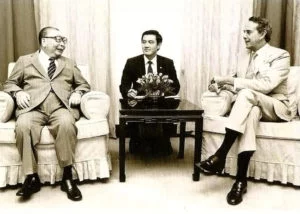
A young Ma Ying-jeou serves as interpreter for president Chiang Ching-kuo in 1981 (photo: cn1n.com).
Among scholars of democracy, Taiwan’s transition to democracy in the late 1980s is often characterized as a “transformation.” As opposed to “transplacement” or “replacement,” transformations are characterized by the government in power heading up the transition, with no overthrow of the previously ruling state. However, the simplistic characterization of Taiwan’s democratic transition as a “transformation” has allowed the KMT to create and sell a global narrative that obfuscates the innumerable human rights violations committed under its regime. Had it not faced growing discontent within the populace, increased organization by clandestine opposition groups who had suffered many years of persecution under the KMT-imposed martial law, and external democratization pressure in a post-Cold War era, it is likely that the KMT’s now oft-stated purpose of transitioning to democracy would never have become reality.
Minimization of Taiwanese suffering during the White Terror
11:13 “… in 1993, when I became justice minister, the government already published a report which says that roughly, roughly, about 18,000 people they estimate, got killed. And they decided to do some reparation, compensation, and trying to restore the peoples’, sort of, uh, rights.”
12:45 “Originally we set a deadline for reporting the incidents of cases of death, or injury, or detention, loss of liberty, whatever… it was 13 years for people to report. So according to the last figure, it’s uh, 868 people dead or missing. Which is very different from the number used in Taiwan, by scholars… but after 13 years, most people, if not all, must have reported.”
In his talk on March 1, Ma seemingly acknowledges that there is still information to be learned, and acknowledges Taiwanese society’s increasing pivot to transitional justice. This is consistent with his remarks in Taiwan two days earlier, where he stated that that although the KMT has done “almost everything it can to make reparations, “we should keep pursuing new threads and information if there are still any. This should be the attitude adopted by both the pan-blue and pan-green camps.”
However, although the rhetoric about reparations already being completed is consistent, Ma’s statements in New York are tinged with denialism. He first casts doubt on the number of people killed, then contextualizes the 228 Massacre as a mere instant of regrettable violence instead of a precedent for years of cultural subjugation and violent suppression of all opposition. In Taiwan, Ma’s statements acknowledge the role of the KMT in the 228 Massacre — at least more so than in the past. However, his rhetoric in the United State two days later deliberately distances the KMT from the events in question and allows him to maintain a revisionist account of life under martial law and the KMT’s role in Taiwan’s democratic transition.
Conclusion
The remainder of Ma’s talk was, as might be expected, a prolonged defense of his presidency. However, more disconcerting is his continued misrepresentation of Taiwanese history and revisionism in a global context, despite changes in the KMT narrative in Taiwan. It is obvious that as much as Ma might show up at 228 memorial events and pay lip service to victims around election time, he and other KMT members have no intention of modifying their narrative in the global context. The KMT’s portrayal of its history runs counter to its claims of commitment to transparency. If the KMT continues to downplay the corruption and bloodshed of its authoritarian rule, continued criticism levied against the party will be justified, and its continued existence will serve only to hold Taiwan back from strengthening and legitimizing its existing democratic institutions. Those within the KMT who seek to uphold liberal democratic values would do well to confront the limiting factors in their midst.
You might also like
More from Society & Culture
Media and Free Expression in Taiwan Are Under Attack: What Can be Done?
How can we avoid the imposition of a blanket silence which can only empower our enemies and damage our democracy? …
Taiwanese Views on Homosexuality Based on Proximity of Relationship, Study Shows
The legalization of same-sex marriage in Taiwan should be viewed not just as a culmination of years of advocacy efforts …
Challenges Remain Following the Legalization of Same Sex Marriage in Taiwan
Despite the adoption of a new law on May 17, campaigns will continue to legitimize the kind of homophobic discourse …


